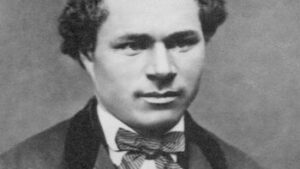
Hans Jonatan
*Hans Jonatan was born on this date in 1784. He was a Black slave, soldier, farmer, and trader.
Also known as Hans Jónatan and Hans Jonathan) he was born on the plantation of Constitution Hill on the island of St Croix in the Danish West Indies, a Danish colony in 1733 when purchased by the Danish West India Company from France. His father was a white Danish man, Hans Gram; his mother was Emilia Regina, a Black African 'house slave' who first worked in 1773 at the St Croix plantation of La Reine, where she was presumably born.
In 1788, Emilia had a daughter, Anna Maria, by a black man, Andreas, who at the time was a house slave, too. The details of Hans's mother's West African ancestry were unknown before a genetic study. Jonatan was a slave to Heinrich Ludvig Ernst von Schimmelmann and his wife Henriette Catharina. In 1789, the Schimmelmann family moved to Copenhagen, bringing Jonatan. Heinrich died, bequeathing him to his widow, Henriette Catharine. In 1801, at seventeen, Jonatan escaped and joined the Danish Navy. He participated in the Battle of Copenhagen, for which he received recognition.
Danish crown prince Frederick gave him his freedom. Henriette then had Jonatan arrested, claiming that he was her property and that she had intended to sell him. Jonatan and his lawyer argued before a Copenhagen court; he was sentenced to the West Indies on March 31, 1802. Jonatan escaped again, and his fate remained unknown to the Danish administration. It was only around the 1990s that the rest of his story was pieced together and started to become generally known. In 1802, he arrived in Djúpivogur in Iceland as an agent at the trading post.
Hans lived as a peasant farmer at Borgargarður, working at the Danish trading station in Djúpivogur. One of the first records of Hans Jonatan after 1802 is in the diary of the Norwegian cartographer Hans Frisak for August 4, 1812; Frisak hired Hans Jonatan as a guide. He took over the running of the trading post in 1819. By February 1820, Hans had married Katrín Antoníusdóttir from Háls on the Eyjafjörður. They had three children: two survived childhoods, and their descendants now numbered nearly nine hundred. Hans Jonatan died on December 18, 1827.
Genetic study.
In 2018, scientists achieved a genetic breakthrough when they reconstructed a part of his genome solely using samples from his descendants and none from his remains. The samples were analyzed against known signs of African DNA, recreating about 38% of his mother's DNA profile and, thus, 19% of his own. It was determined that his mother's ancestral origins were from a region now encompassing Nigeria, Benin, and Cameroon.
A biography of Jonatan by Gísli Pálsson was published in Icelandic in 2014. An English edition titled The Man Who Stole Himself: The Slave Odyssey of Hans Jonathan was published in 2016. A documentary based on the book premiered in 2017. In 2023, a Danish community theatre company, Hammermøllens Teatergruppe, performed the musical En Fri mand (English: A Free Man) about the life of Hans Jonatan.